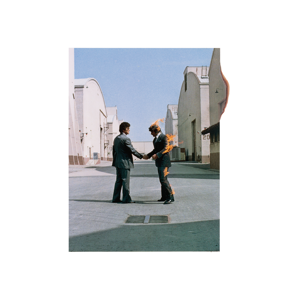
The
previous two Dire Straits albums sported a sublime mix of storytelling and atmospherics, and were much bigger overseas than in America. Whether or not it was a conscious decision,
Brothers In Arms tells few stories and buries the few melodies in contemporary mush from a pile of session cats augmenting what used to be a tight little combo. And the lyrics, previously worthy of the pen of a former English teacher, sound dashed off. Where he used to edit for quality, henceforth Knopfler songs (and albums) will simply run long.
Despite all this, it sold by the bucketful for the next two years, usually to people with new CD players needing something familiar to show off. Even the words “A FULL DIGITAL RECORDING” were emblazoned on the cover in the same typeface and weight as the artist and album title. This was also one of the first albums to take advantage of the extended CD playing time, with four tracks on what we still call side one longer on cassette and disc than the record. (That’s not always a good thing.)
“So Far Away” is mostly inoffensive, if a bit simple, but “Money For Nothing” got all the attention, thanks to its recognizable riff, Sting vocal and early anti-MTV stance. “Walk Of Life” took that grating accordion phrase to endless ESPN highlights reels. “Your Latest Trick” expands on the smooth jazz leanings of the previous album with too much saxophone, underscored by the sappy trumpet in the lounge intro lopped off the LP version. “Why Worry” would have been one of the slighter songs on the earlier albums, but here it stands out for its unobtrusiveness; this one runs over three minutes longer on the non-vinyl program.
Side two is concerned with world events and social commentary, but at least it’s comparatively shorter. “Ride Across The River” uses keyboards to evoke some far-off jungle, with that ubiquitous flute effect and, of course, crickets, but distinctly mariachi trumpets. “The Man’s Too Strong” is predominantly acoustic-based, and that’s intriguing enough, but “One World” kills the mood with its dopey arrangement and dopier words (or lack thereof). Of the four songs on the side, the title track is by far the strongest and most eloquent statement, but still a pretty depressing way to finish it off.
Brothers In Arms was an unlikely candidate for the arena-rock champion of the year, going head to head with Bruce Springsteen, and we’re still not sure how it happened. It has not aged well—mostly because of the DX7 synth effects everywhere and canned drums—and the hits tend to get lumped in with the usual “hey, remember the ‘80s?” suspects. It’s really too bad, considering how above-average Dire Straits used to be, and so recently in hindsight. They were never the same again.
The album also fits into our flimsy theory of The First Four, in which a band’s initial four albums can fit on two Maxell XLII-90 cassettes and follow this pattern:
1) the striking debut, catching all the attention and putting the pressure on;
2) the forced follow-up, usually written on the fly and criticized as a retread;
3) the make-or-break statement of purpose, which takes them into the stratosphere;
4) “we’ve been to the mountaintop, and this is what we saw there”
And after that, the fifth album can confound or please the listener. It’s not a perfect system, but possible demonstrations include R.E.M, U2, Coldplay, Springsteen, Led Zeppelin, and Toad The Wet Sprocket. (One day we’ll have it all worked out.) This was Dire Straits’ fifth album, and was too long to fit on one side of a Maxell anyway.
The album’s 40th anniversary was celebrated with the expected vinyl reissue, with the shorter edits intact, as well in expanded packages that included a concert from that busy summer. Amazingly, their set started with a ten-minute “Ride Across The River”, easing the crowd in before blasting into “Expresso Love” and a run through the more expected staples and four other songs from the new album. There are a lot of extended workouts—“Wild West End” runs over nine minutes, and “Tunnel Of Love” more than twice that—but the crowd even stays engaged in quieter tunes like “Why Worry”. These two discs would have been an excellent inclusion in 2024’s Live 1978-1992 box set, but that’s why people get degrees in marketing.
Dire Straits Brothers In Arms (1985)—2½
2025 40th Anniversary Edition: same as 1985, plus 15 extra tracks
 Bowie was certainly one of the first artists to embrace the Internet as a social tool as well as a promotional one. His next stunt was to have a contest wherein one of his subscribers would write lyrics for a song he’d then record for his next album. He made good on the offer, too.
Bowie was certainly one of the first artists to embrace the Internet as a social tool as well as a promotional one. His next stunt was to have a contest wherein one of his subscribers would write lyrics for a song he’d then record for his next album. He made good on the offer, too.













